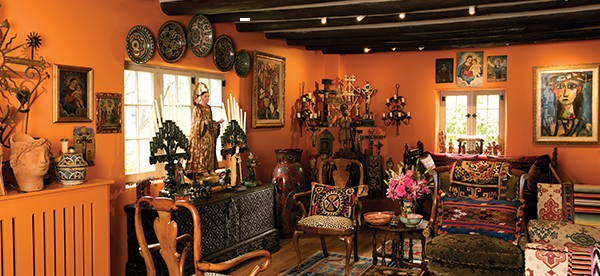Against Minimalism
BY CANDACE WALSH
Minimalism has enjoyed an unquestioned mandate for years. Clean out your closet! Banish clutter! Having a lot of stuff has acquired the whiff of the weird. The conversation’s false binary boils down to a spotless house with off-white everything, vs. Grey Gardens-y rooms stacked to the ceiling with old newspapers and cobwebby tea sets, plus herds of feral cats.
I do get minimalism’s appeal. Our fast-fashion, fast-décor culture encourages us to constantly refresh, recycle, replenish. There’s something so soothing about being in an elegant hotel room with only a bed, a desk and chair, three lamps, a bureau, and a television in its dedicated cabinet. As my eyes take in that spare hotel room, they don’t get snagged on bills to pay, gifts to acknowledge, books to finish. My shoulders relax, and a childlike sense of freedom thrums through my veins.
But something gets lost in kowtowing to this minimalism virtue silo: mementos. In my home, there’s a small tree made out of upcycled metal and beach glass that I bought at a Nairobi street market. Little figures made out of corn husks, handed down by my wife’s grandmother, forever sweep a corner of our red bookshelf. Bowls stacked in my kitchen cabinet don’t match, but each one has a story. The blue Pyrex bowl I bought in an upstate New York thrift store when I was kitting out my tiny New York City kitchen nests inside the gray, snail-dotted Scandinavian bowl my kids used for cereal when they were small. I have emotional relationships with the objects and they have temporal relationships with each other. They remind me of different times in my life, in the present moment. A ballast that connects me to my past, these objects counterbalance my mind when it races ahead to think about what I need to do tomorrow, next week, next month. I appreciate the soft, intentional energy coiled within a handmade mug, along with the machine-made, mid-century pizzazz of a melamine tray.
Judy Espinar shares my love of objects’ power to evoke, but in that realm, I’m dribbling a ball in my back yard, and she’s LeBron James. “The People’s Art” whisks you right into Espinar’s folk art-filled house, where eyes have no call to glaze over.
Hundreds of handmade figures, plates, and other objets attest to her decades of un-precious, heart-connected collecting. Each object has its own personality—and their personalities, thanks to Espinar’s curatorial vision, miraculously harmonize. When she looks at an object, she can remember the maker, what inspired them, where they live, and how her purchase helped sustain important traditions. Our article corresponds to Espinar’s gift of much of her collection to the Museum of International Folk Art, and its exhibition opening December 16, A Gathering of Voices: Folk Art from the Judith Espinar and Tom Dillenberg Collection.
My desk holds a lovably chunky Japanese clay dish in the shape of a cloud from the O’Keeffe Visitor Center’s gift shop in Abiquiu. I see the color of the tan clay at its edges, where the snowy-sky white glaze thins, and I remember the feeling of being in the artist’s deliberately furnished house. A mush- room-beige handmade mug I bought in a Sag Harbor gift shop, during a rare day spent with my father and stepmother, allows me to connect with that warm memory whenever I fill it with coffee or tea. Years from now, the delicately fluted, wheel-thrown vessel will not only remind me of that seaside idyll, but of my El Palacio office. Maybe some of us just need to spend more time in the past than others. Given that you have a history-heavy magazine in your hands, there’s a good chance you’re one of my kind.

